A collaborative control room is an expensive investment that one can expect to operate for 8-10 years, or possibly longer, before a major technology refresh. It is likely that over this time period, requirements for the control room will change due either to an evolving mission and workflow or advancements in technology. Designing a control room which meets all unknown future requirements when delivered is impractical, costly, and realistically impossible. This does not mean possible future requirements should not be considered in your control room specification. These potential requirements should be tracked. Control room specifications should ensure the requirements are met by adding to the initial system without major disruption to existing workflows and infrastructure.
Scalability is simply the property of a system to handle growth by adding resources to the system. In visual collaboration systems, scalability is often considered in terms of the number of inputs and outputs. However, the ability to add capacity is only one of many types of scale. A measurable growth in any facet of operations naturally precipitates growth across other areas. Other types of scalable needs operations incur include:
- Functional: Adding new functionality to a system to meet changing requirements.
- Generational: Adopting new generations of components.
- Heterogeneous: Implementing components from different vendors.
- Administrative: Increasing the number of organizations or users to access a system.
- Geographic: Expanding the geographic footprint from a local area to a larger region.
Each of these areas of scalability allows an organization to meet changing mission requirements, and when appropriately planned for, supports expansion with minimal interruption of existing operations. The same is true for the control room visualization system. A platform designed to scale over time increases the system’s effective lifecycle and controls costs.
The most common changes in a system’s scale and scope involve adding video inputs and outputs to the system, often in spaces outside of the original control room. Network-based video distribution systems allow inputs and outputs, including additional video walls, to be added incrementally as required. These additional sources can be added using the control room’s existing infrastructure without causing any disruption or downtime on the overall system.
A change in size is often triggered by a change in the mission scope. For example, the addition of control room spaces may be due to a new mission requirement. In the future, a separate operational team might need to access main control room sources and publish content to the control room display wall while maintaining autonomy from the workflows in the main control room. In this case, a collaborative control room system may require that functional and administrative scalability features be added, with access to specific sources and outputs being limited to a subset of users. This is one of endless scenarios control rooms frequently encounter. Whether adding teams, facilities, geographic scope, or new technology, management must strategically anticipate growth opportunities to futureproof operations.
You can learn more about detailed scalability considerations for control rooms to meet both your current and future operational requirements in our recently published white paper, Evaluating Scalability for Control Rooms, available for download here.
